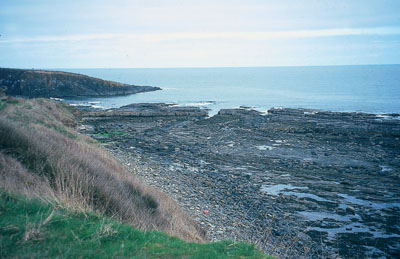 |
This stretch of coastline is a paradise for rock anglers with enough deep weedy gullies to keep most cod fishing fanatics happy for the rest of their days.
These marks produce tremendous catches of cod throughout the year. During winter the area is much neglected by anglers with only a few of the more enterprising venturing north to reap the rewards. Following any onshore winds the cod shoals move inshore to feed heavily on any food loosened by the crashing waves. Last season numerous fish to double figures were landed, topped off by a few 20-pounders.
In the summer sport can be equally good, although calm seas will produce the best catches, when cod, coalfish, pollack and ballan wrasse are taken in good numbers. This area is also popular with the scuba-diving fraternity with very deep water within a few yards of the shore.
1.LONGHOUGHTON STEEL
There is a narrow track that leads from
2. HOWDIMENT ROCKS
From Longhoughton the track continues in an easterly direction. When you reach the sea it turns north and runs alongside a small sandy beach, which is known as
3. SUGAR SANDS
This sheltered, sandy bay has a reputation for producing superb catches of codling throughout the winter months. Most of the fishing takes place over the low-water period, casting from the rocky skeers protecting both sides of the bay. On the flooding tide you can fish the beach over the high-water period. Cod are the main quarry although coalfish and a mixture of flatfish are landed during the summer and autumn months. In the winter, however, cod will dominate and fish to double figures are possible. A big bait made up of black lugworm tipped with peeler crab, squid, white ragworm, razorfish or clam will do the trick.
4. HOWICK HAVEN
The Haven is one the best cod marks on the
5. DOCTOR’S HOUSE
The rock edges fronting the Doctor’s House can be fished at any stage of the tide. They are capable of producing some spectacular catches of cod with a few pollack and coalfish mixed in. The water is very deep and the bottom is pretty rough so experiment by casting different distances, trying to land your baits onto the sandy patches in between the weed beds. This is a superb summer mark that will give up good numbers of red codling to fresh peeler crab baits. This area is also a popular walk for bird-watchers and ramblers. In the winter months cod are the main quarry and fish to double figures are landed every season, with sport peaking at the turn of the year. The marks stretch for some 400 yards, so there is ample room with no fear of being crowded out.
6. SWINE DENE
This is another low-water mark surrounded by very deep water and is beside the famous Cullernose Point Rocks. When you cast out your sinker it seems to take an age to reach the bottom that is pretty rough. Consequently tackle losses can be high. With this in mind, most anglers use 35lb main line straight through and a rotten bottom system. When you hook a fish a speedy retrieve is the best tactic because of the depth of the water and the rough terrain. On a calm summer evening sport can be brilliant with red codling, pollack, coalfish and ballan wrasse all keen to snap up your fresh peeler crab baits. In the winter, however, lugworm takes over as the top bait when cod to double figures are possible.
TACKLE SHOPS
AMBLE ANGLING CENTRE, Newburgh Street, Amble. Tel: 01665 711200.
JOBSON’S OF ALNWICK, Tower Showroom, Alnwick. Tel: 01665 602135, e-mail: fishing@jobsonsofalnwick.co.uk
TSF Top Tip 1
Make sure you use big, strong hooks if you intend going after a lunker cod. There are plenty of upper doubles and even 20lb fish here.
TSF Top Tip 2
If you fancy some sport, try spinning with head-hooked sandeel on a lighter rod for coalfish and pollack in good numbers.





